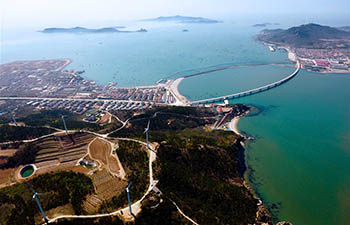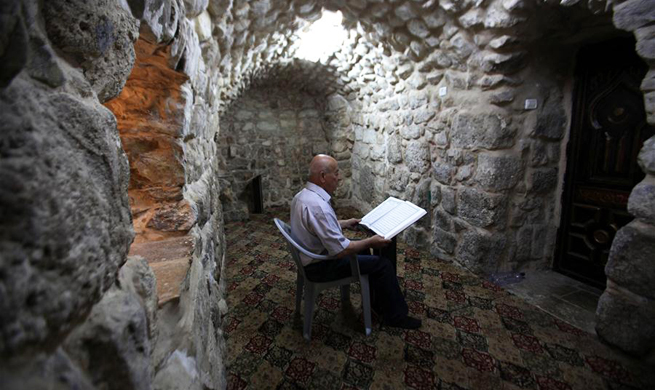by Burak Akinci
ANKARA, May 29 (Xinhua) -- Turkey's must-see ancient site Gobeklitepe is getting ready to be added to the UNESCO World Heritage List with a new roof protection.
Located in the southeastern Turkish province of Sanliurfa and close to the traditions and mythical Garden of Eden, 18 km from Sanliurfa's city center, Gobeklitepe was first discovered in 1963 during surface survey of researchers from Istanbul and Chicago Universities. Works have been continuing in the ancient settlement for 54 years.
Gobeklitepe has been well-hidden beneath mounds of mud and debris. Numerous animal skeletons have been unearthed leading international researchers to believe the temple was used for animal sacrifice.
On site, T-shaped pillars weigh between 40 and 60 tones each and the pillars run from 3 to 6 meters high. Near perfect rendering of bulls, foxes and cranes leap from the stone while one may observe with fascination relief sculptures of crocodiles, boats and lions.
Considered by many international organizations as the world's oldest temple dating back to 12,000 years ago, Gobeklitepe entered the UNESCO World Heritage Tentative List five years ago. The site is expected to enter the permanent list next year.
Final preparations for the UNESCO nomination are continuing in Gobeklitepe. Works to establish a nearly 4,000-sq. meter steel roof is being finished to provide a better and sturdy protection for the ancient site.
Sanliurfa Provincial Culture and Tourism Director Aydin Aslan said to the Anadolu Agency that Gobeklitepe was a huge excavation site that changed the world's archaeology history to a great extent, adding that excavations were continuing non-stop in the region.
The city is home to the world's oldest temple, which is believed to be twice as old as the Stonehenge and the Pyramids.
Ancient stone carvings and a tablet analyzed at this mysterious site could eventually confirm, even there are some critics to this new theory, that a comet struck earth around 11,000 BC. Experts at the University of Edinburgh, Scotland, analyzed mysterious symbols carved onto stone pillars at Gobeklitepe to find out that they could be linked to constellations.
The markings, according a research published in Mediterranean Archaeology and Archeometry, suggest that a swarm of comet fragments hit earth at the time that a mini ice age struck, changing the course of human civilization.
Researchers believe the images on the pillars were intended as a record of cataclysmic event, and a further carving showing a headless man could possibly indicate human disaster and massive loss of life.
This site is contemporary with the Greenland ice core samples, which are dated to around 10,900 BC of the sites may features, none are more famous than the many standing pillars that dot the excavated grounds.
This is because of the extensive programs and animal reliefs that decorate these pillars, which include various representations of mammal and avian species. One of the pillars, known as the "vulture stone," was of particular interests to archaeologists, as it is suspected that its representation which is associated with death could have been intended to commemorate a devastating event, like a cataclysm.
The Turkish official Aslan said the roof works are expected to be finished on July 15. "As of July 15, the roof project will be finished and the area will be open to visitors. The priority of works is the protection of Gobeklitepe. The cost of this work is nearly 600,000 euros, provided by the Turkish state and the European Union," he added.
The head of the Gobeklitepe excavations team, Celal Uludag, said for his part that the excavations will be delayed because of the roof project in the field.
He said the protection of the field of historical artifacts is as important as the protection of the artifacts, and that new findings can also be unearthed during upcoming excavations. He said they have been planning to start excavations in the region for long years.
"We will start excavations after the roof project. We believe that we can continue excavation works in the settlement for long years. So far, seven temples have been unearthed in the region and many of them are waiting to be discovered. It is important to protect and display the findings. Now we give priority to the protection of the current findings," he added.
Gobeklitepe was discovered in 1963 as a Neolithic settlement, during the surface surveys realized as a part of a Joint Project named "Prehistoric Research in Southeastern Anatolia" by Istanbul University in cooperation with Chicago University.
The site is composed of approximately 20 round and oval structures. There are two T-shaped free-standing pillars of 5 meters long. Monumental structures of Gobeklitepe were deliberately filled with soil by the people of the Neolithic period who built them, which is why the findings have survived without any damage.
Symbolism on the pillars of Gobeklitepe also indicates that the long-term changes in earth's rotational axis was recorded at this time using an early form of writing, and that the site was an observatory for meteors and comets.
Thus according to many researchers, the 12,000 year Megalithic site, and a real archaeological enigma, was somewhat purposefully buried by its builders as a time capsule to tell us what happened then.
Many tourists visiting Turkey have never heard of Gobeklitepe and have no idea of the existence of this wonder of the ancient world. Those who choose to take the time to go there are overwhelmed and say it's one of the places that they will be forever engraved in their minds.

















